南漪湖上覆水溶解性有机质的光谱特征
2022-07-19李海斌谢发之李国莲翟红侠袁志伟
李海斌,谢发之*,李国莲,翟红侠,龚 雪,刘 站,罗 锟,袁志伟
南漪湖上覆水溶解性有机质的光谱特征
李海斌1,2,3,谢发之1,2,3*,李国莲2,翟红侠1,3,龚 雪1,3,刘 站1,3,罗 锟1,3,袁志伟2
(1.安徽建筑大学材料与化学工程学院,安徽 合肥 230601;2.水污染控制与废水资源化安徽省重点实验室,安徽 合肥 230601;3.安徽省先进建筑材料国际联合研究中心,安徽 合肥 230601)
为考察南漪湖上覆水中溶解性有机质(DOM)的光谱特征与来源,采用紫外-可见光吸收光谱(UV-Vis)与三维荧光光谱(EEMs)为工具,并结合平行因子分析(PARAFAC)、荧光区域积分分析(FRI)、相关性分析、主成分分析与聚类分析对DOM进行定性与定量分析.结果显示,UV-Vis参数(440)、2/3、3/4、R表明DOM具有腐殖化特征与自生源特征,且2/3、3/4与(440)呈显著正相关关系(<0.01,<0.05),R与(440)无显著相关关系(>0.05),说明腐殖酸浓度越高则DOM相对分子量越大,但无法依据腐殖酸浓度大小判断DOM来源.根据(440)计算获得溶解性有机碳(DOC)平均浓度为26.79mg/L,且该湖泊出口附近DOC浓度为10.15mg/L.荧光指数(:、FI、BIX、HIX、Fn(280)、Fn(355))显示该湖泊DOM具有腐殖化程度较低及强自生源特征,类蛋白组分(Fn(280))相对浓度的空间分布上由西向东逐渐增大,而腐殖酸类组分(Fn(355))相对浓度峰值出现在入湖口与出湖口.通过PARAFAC解析出3种组分,分别为类富里酸(C1)、类色氨酸(C2)和类腐殖酸(C3),且C1、C2、C3含量分别占总组分强度21.96%、13.36%、84.21%.FRI法分析显示类蛋白物质所占比例之和(区域I + II)为49.65%,该结果说明水体已受到了人为因素影响.通过相关性分析结果显示,C1、C3与、BIX呈显著负相关系(<0.001),C2与:、BIX、Fn(355)呈正相关系(<0.001).通过主成分分析与聚类分析,南漪湖上覆水中DOM在16个位点间呈现不同特征,但整体上水体中DOM来源受内源输入影响较为显著,应加强该湖泊内源释放污染物控制与管理.
溶解性有机质;紫外-可见吸收光谱;三维荧光光谱;平行因子分析(PARAFAC);荧光区域积分分析(FRI);聚类分析
南漪湖位于宣城市宣州区与郎溪县交界,其属于泥沙长期封淤积水而成的浅水湖泊[1].该湖泊作为长江下游南岸外流淡水湖,其水源主要来自新、旧郎川河,且水源经过新河庄汇入水阳江后直达长江[2].由于该湖泊受人为活动影响,其生物化学参数(浮游植物组成、叶绿素浓度、总氮磷浓度)表明该湖泊已由富营养化初级阶段向中级阶段过渡[3].另外,溶解性有机质(DOM)作为非均质高分子化合物,其容易影响水体中各种污染物的迁移与转化[4].南漪湖水体中DOM不仅影响其自身生态功能,而且对长江流域生态系统也会构成重要影响.为此,揭示南漪湖上覆水DOM组成、空间分布及来源具有重要意义.
三维荧光光谱(EEMs)与紫外-可见光吸收光谱(UV-Vis)是表征DOM分子结构、组成与来源的重要技术,尤其在开展湖泊DOM溯源方面已存在诸多报道.Wang等[5]以EEMs研究了呼伦湖水体中DOM组成与来源,该湖泊DOM浓度达到6.46~42.87mg/L,且浓度变化表现为夏季最高、冬季最低,冬季受结冰使得DOM空间分布呈显著差异,湖岸周围浓度高于湖中心,该湖泊DOM主要由类腐殖质与类蛋白组成,陆源是该湖泊DOM主要来源.Lü等[6]采用EEMs解析了太湖DOM与颗粒有机物(POM)中荧光组分及来源,其荧光指数的时空分布表明POM主要来自内源, POM夏、秋季以类蛋白为主,冬、春季以类腐殖质为主,类色氨酸对POM成分贡献最大,河口处POM与其它区域相比表现出更多外源性特征,而湖泊中DOM则主要表现为内源特征.由于UV-Vis可提取DOM特征光谱参数,进而获取DOM类型、相对浓度、芳香性强弱、疏水性组分含量等信息,将该光谱与EEMs相结合有其必要性.Wang等[7]将EEMs与UV-Vis结合剖析太湖水华暴发早期上覆水体DOM,其DOM主要由酪氨酸、类色氨酸与类腐殖质组成,有色DOM在波长280,350nm处的紫外吸收系数分别为6.63~29.87,1.84~10.41m-1,全湖DOM浓度为2.86~11.83mg/L,且浓度从东南向西北呈上升趋势,水华早期上覆水中DOM主要来自藻类活动及代谢.Ren等[8]采用EEMs与UV-Vis考察不同水文条件下南四湖水体DOM分布特征,该湖泊中DOM主要来自内源释放,空间尺度上湖底腐殖质含量与腐殖化程度比湖面低,时间尺度上DOM贡献表现为类腐殖质比类蛋白强,该结果可能与南水北调及沉水植物衰亡有关.由于南漪湖点源污染及农业面源污染负荷增加,围栏养殖过程也未采取较好控制措施,其生态系统功能已呈退化现象.该湖泊中DOM信息尚不明确,采用EEMs与UV-Vis结合考察该湖泊上覆水DOM光谱特征,有利于从定性与定量角度揭示DOM性质、浓度、分布特征等,理论方面能系统阐释各光谱参数间相关性,实践方面可为长江中下游湖泊群水质数据完善、环境治理及风险防控等提供参考.
通过采集南漪湖不同位点水面(上覆水)水样,利用UV-Vis与EEMs考察该湖泊上覆水DOM光谱特征,并结合平行因子分析(PARAFAC)、荧光区域积分分析(FRI)、相关性分析、主成分分析与聚类分析对该湖泊DOM组成、分布与来源等情况予以解析,以期为南漪湖水生态环境决策与保护提供科学依据.
1 材料与方法
1.1 样品采集
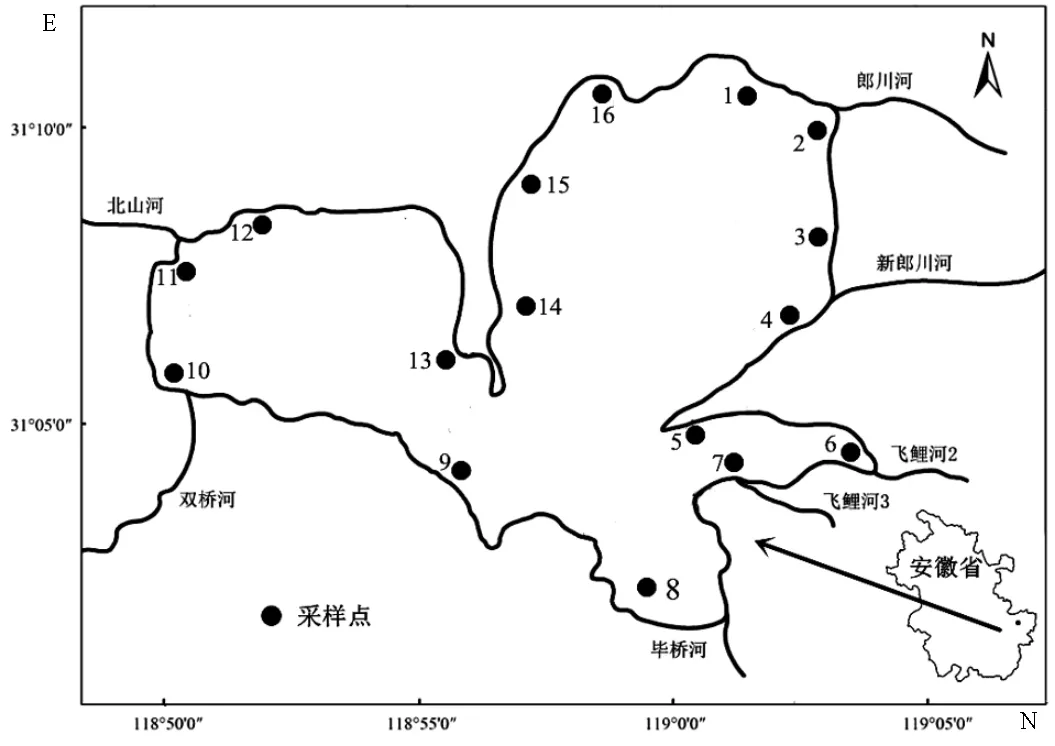
图1 采样点示意
根据南漪湖水源入口与出口位置选取16个典型采样点,于2020年11月28~29日对南漪湖上覆水进行采样,具体位置如图1所示.采样时通过GPS定位器定位,在租赁渔船上通过有机玻璃水质采样器采集水面最上层水,采集水样装入已清洗的不透明聚四氟乙烯瓶中保存,并及时运至实验室处理.水样用0.45μm滤膜过滤获得待测液,并将待测液及时进行光谱检测,其pH值、电导率、溶解氧浓度采用便携式水质测定仪现场测定.
1.2 光谱分析
采用UV-5500PC紫外可见分光光度计(上海元析仪器有限公司)测定UV-Vis,以超纯水作为空白样品,室温条件下在1cm光程石英比色皿中测试,扫描波长为200~700nm.吸收系数采用公式(1)、(2)计算[9],2/3值、3/4值分别通过250与365nm、300与400nm处吸光度之比计算[10],光谱斜率R计算为275~295nm与350~450nm区域光谱斜率之比.EEMs测定采用F-4700荧光分光光度计(日立高新技术公司),基本参数为:光电倍增管(PMT)电压为700V;激发与发射狭缝宽度均为5nm;响应时间为自动;扫描速度为12000nm/min,设置激发波长(x)为220~ 450nm, 发射波长(m)为280~550nm.新鲜度指数(:)为x=310nm时,m在380nm荧光强度与420~ 435nm波段最大荧光强度比值;荧光指数(FI)为x= 370nm时,m在450nm与500nm处荧光强度比值[11];生物源指数(BIX)为x=310nm时,m在380nm与430nm处荧光强度比值;腐殖化指数(HIX)为x= 254nm时,m=435~480nm与m=300~345nm的荧光强度积分值的比值;Fn(280)、Fn(355)分别为x= 280nm处m=340~360nm间最大荧光强度、x= 355nm处m=440~470nm间最大荧光强度[12-14].


式中:为波长,nm;*()为条件下未去除误差的吸收系数,m-1;()为条件下去除误差的吸收系数, m-1;()为条件下吸光度;为光程路径,0.01m.
1.3 数据处理与绘图
采用Matlab 2019b软件对EEMs进行PARAFAC与FRI分析,采用Origin 2021b软件进行相关性分析、主成分分析与聚类分析,绘图工具为软件Origin 2021b与Sufer 8.0.
2 结果与讨论
2.1 水体理化性质
南漪湖上覆水理化性质如表1所示,上覆水平均pH值为7.58,标准偏差为0.13,水质呈弱碱性.水体平均电导率为380.56mS/cm,其数值较大,且其最大值与最小值差距较大.水体平均溶解氧浓度为9.26mg/L,水体呈现好氧状态.

表1 上覆水理化性质
2.2 紫外-可见吸收光谱
图2(a)为DOM的UV-Vis曲线.由于受环境因子、水动力作用、光化学催化、生物化学等过程影响,各位点间UV-Vis曲线强度存在明显差异[15].吸光度均随波长增加呈减小趋势,且226~250、250~280nm处吸收峰分别由无机阴离子、木质素磺酸及其衍生物组分所引起[16-17].如图2(b)为不同位点(440)变化图,在位点16处(440)达到最大值8.19m-1,即说明位点16处腐殖酸浓度最高[18].由于地理位置显示该处远离河流入口,水动力条件不足会使水体复氧能力衰退,此外水温增高会加快微生物及藻类残体分解有机物速度,从而增大水体腐殖化程度.如图2(c)为(440)、2/3、3/4、R变化,其值波动分别为0.66~8.19、2.85~7.40、1.37~7.57、0.01~4.32,均值分别为(2.37±1.12)、(4.66±1.34)、(3.92±1.24)、(1.48± 0.46).DOM分子量与2/3值呈负相关性,南漪湖2/3值与Erlandsson等[19]报道的湖泊2/3平均值4.70高度接近,说明两湖泊间水体DOM分子量相似.腐殖化程度与3/4值呈负相关性,南漪湖3/4平均值显然高于3.50,但56%位点要低于3.50,说明南漪湖腐殖质主要以类腐殖酸为主[20].南漪湖81%样品R值均大于1,说明南漪湖上覆水DOM主要来自内源释放,其释放途径主要为水生物代谢与生物残骸腐化等作用[21].图2(d)显示(440)与2/3、3/4呈显著正相关系(<0.01,<0.05),即说明腐殖酸浓度高则DOM分子量相对较大.其可能是在自然环境或在光谱检测过程中,光照条件会使大分子量DOM发生降解形成了小分子量DOM,且降解过程中DOM浓度会发生降低[22].由于(440)反映腐殖酸浓度高低,而R反映DOM来源,(440)与R无显著相关性(>0.05),说明在统计学角度无法从腐殖酸浓度判断DOM来源,该结果正好与实际情况相吻合,即无法单纯从腐殖酸浓度明确DOM来源.根据文献[23]中方法可定量计算溶解性有机碳(DOC)浓度,计算的平均DOC浓度为26.79mg/L,该湖泊出口附近DOC浓度为10.15mg/L,此结果用于评估南漪湖上覆水DOM对长江水质的影响.
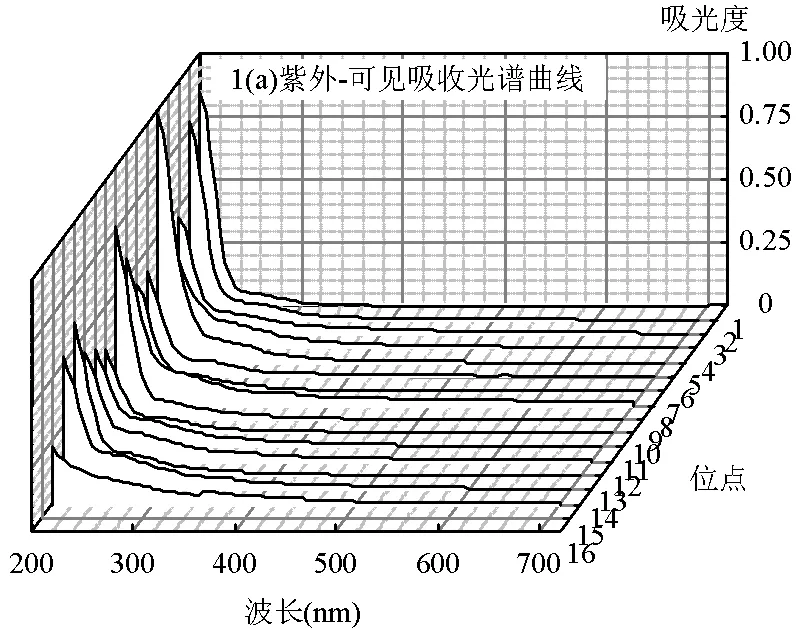
2.3 三维荧光光谱
2.3.1 荧光参数 为考察DOM的EEMs特征,选取荧光参数(:、FI、BIX 、HIX、Fn(280)、Fn(355))进行分析,结果如图3所示.:变化为0.92~1.68,其平均值为(1.06±0.10),说明水体中新生DOM较多,且水体生物活性较高,内源特征较为明显.FI变化为1.71~2.49,其平均值为(1.95±0.14).当FI<1.20、FI>1.80、1.20 2.3.2 荧光组分 利用PARAFAC对DOM的EEMs进行分析,核心一致度评价最优主成分为3,即解析获得主要荧光组分为3种,其相应激发与发射光谱图如图4所示.组分主要为2个类腐殖质组分(C1,C3)和1个类蛋白组分(C2),且3种荧光组的光谱特征如表3所示.C1组分在天然水体中广泛存在,属于陆源性短波小分子类微生物腐殖质,其不易光降解及生物降解,主要来源为森林地区、湿地、地表径流、土壤渗滤液等,与细菌以及藻类细胞释放的胞外腐殖质类似[37].C2组分最大波峰特征显示其主要来源为水体内部产生的低激发态类色氨酸物质,属于游离或结合在蛋白质中的微生物代谢产物.C3组分为与富里酸相似的大分子疏水性长波类陆源UVA类腐殖质, 其主要来源为陆源,该组分可光降解及生物降解,但生物降解、生物活动是其潜在的二次来源. 表2 不同水体中DOM光谱参数对比结果 根据Zhou等[43]方法将DOM荧光区域分成5个区域,其划分情况如表4所示.由于FRI法是将定量分析与光谱学相结合的有效方法之一,可以较为细致阐明DOM组成与荧光光谱变化规律[44].图5(a)为南漪湖上覆水区域积分面积百分比堆积图,溶解性微生物代谢副产物在湖入口位点6处浓度最高,在湖入口位点4处浓度最低,该结果应是生物活动与水动力相互作用结果.色氨酸类蛋白浓度在湖入口位点7处最高,说明此处受到人为活动影响最大.图5(b)为积分体积与百分比平均值图,区域II平均百分含量最高为34.29%,其在26.18%~47.21%波动变化,芳香类蛋白物质浓度较高则说明水体容易受到污水排放影响.区域III平均百分含量(29.61%)次于区域II,说明紫外光区类富里酸浓度较高,DOM受到沉积物与河流中陆源腐殖质影响.区域 IV与V平均百分含量分别为14.17%、6.57%,而类蛋白物质所占比例之和(区域I +II)为49.65%,进一步说明水体已受到人为活动影响. 表3 荧光组分特征 表4 5个积分区域划分 图5 FRI分析结果 为考察DOM荧光组分与光谱参数间关系,采用Pearson相关性分析与主成分分析(PCA)对DOM进行解析.图6(a)为相关性分析结果,:、BIX、Fn(355)与C2呈正相关系(<0.001),:、BIX与C1、C3呈显著负相关系(<0.001).PCA分析结果如图6(b)所示,PCA1与PCA2分别解释了48.30%、28.00%(共解释76.30%变化).PCA显示采样点分布相对较为分散,表明不同位点间DOM存在显著差异.图7为南漪湖上覆水DOM研究思路,通过荧光区域积分面积百分比数据进行聚类,结果显示位点分布相对分散.南漪湖上覆水DOM可以聚为4类,第一类主要是郎川河支流附近的样品,第二类主要是距支流较远样品,第三类主要为飞鲤河支流附近样品,第四类为前面三类所剩余样品,说明该湖泊中DOM具有不同来源,其存在差异原因主要受地理位置、环境因素及人为因素影响. 综上所述,由于南漪湖属于浅水湖泊,水体流动性强使得DOM腐殖化程度低. 陆源与自生源共同作用是DOM来源,但主要以内源输入为主.目前,湖泊DOM主要是内源输入有南四湖[8]、五里湖[45]、蠡湖[46]等.然而,南漪湖上覆水中DOM内源输入与该湖泊中芦苇、菱角、莲藕等植物残体腐解及生物代谢密切相关. 3.1 南漪湖上覆水UV-Vis参数(440)为0.66~ 8.19m-1,2/3与3/4值显示南漪湖腐殖质主要以类腐殖酸为主,且(440)与2/3、3/4呈显著正相关关系(P<0.01,<0.05).R表明其DOM内源释放作用较强,且R与(440)与无显著相关性(>0.05).上述参数相关性说明腐殖酸浓度越高则DOM相对分子量越大,而在统计学角度无法从腐殖酸浓度判断DOM来源. 3.2 荧光指数(、FI、BIX 、HIX、Fn(280)、Fn(355))表明DOM来源受外源输入与内源释放共同作用,且腐殖酸类组分(Fn(355))相对浓度在入湖口与出湖口呈现最大值.由于南漪湖为典型浅水湖泊,其DOM腐殖化程度相对较低. PARAFAC分析鉴别获得3种荧光组分,C1为类富里酸、C2为类色氨酸、C3类腐殖酸.FRI法分析结果显示类蛋白物质所占比例之和(区域I + II)为49.65%,说明水体已受到了人为因素影响. 3.3、BIX与C1、C3呈显著负相关系(< 0.001),、BIX、Fn(355)与C2呈正相关系(<0.001). PCA分析与聚类分析显示采样点分布相对分散,说明不同位点间DOM存在显著差异,但DOM来源主要是以内源输入为主. [1] Chen W, Song B, Shu J W, et al. Vegetation history with implication of climate changes and human impacts over the last 9000years in the Lake Nanyi area, Anhui Province, East China [J]. Palaeoworld, 2021,30(3):583-592. [2] Liu J, Shen Z, Chen W, et al. Dipolar mode of precipitation changes between north China and the Yangtze River Valley existed over the entire Holocene: Evidence from the sediment record of Nanyi Lake [J]. International Journal of Climatology, 2021,41(3):1667-1681. [3] Cheng L, Xue B, Zawisza E, et al. Specific species response of Cladocera to the trophic and hydrological environments of lakes: A case study of a typical shallow mesotrophic lake [J]. CATEN A, 2021,207(105630):1-12. [4] Feng L, Zhang J, Fan J, et al. Tracing dissolved organic matter in inflowing rivers of Nansi Lake as a storage reservoir: Implications for water-quality control [J]. Chemosphere, 2022,286(131624):1-10. [5] Wang W W, Zheng B H, Jiang X, et al. Characteristics and source of dissolved organic matter in Lake Hulun, a large shallow eutrophic steppe lake in Northern China [J]. Water, 2020,12(953):1-18. [6] Lü W W, Yao X, Shao K, et al. Unraveling the sources and fluorescence compositions of dissolved and particulate organic matter (DOM and POM) in Lake Taihu, China. [J]. Environmental science and pollution research international, 2019,26(4):4027-4040. [7] Wang S, Wang W, Chen J, et al. Characteristics of dissolved organic matter and its role in lake eutrophication at the early stage of algal blooms—A case study of Lake Taihu, China [J]. Water, 2020, 12(2278):1-17. [8] Ren H, Yao X, Ma F, et al. Characterizing variations in dissolved organic matter (DOM) properties in Nansi Lake: a typical macrophytes-derived lake in northern China [J]. Environmental Science and Pollution Research, 2021,28(41):58730-58741. [9] Li P, Hur J . Utilization of UV-Vis spectroscopy and related data analyses for dissolved organic matter (DOM) studies: A review [J]. Critical Reviews in Environmental Science & Technology, 2017, 47(3):1-24. [10] Oliveira J L, Boroski M, Azevedo J C R, et al. Spectroscopic investigation of humic substances in a tropical lake during a complete hydrological cycle [J]. Acta hydrochimica et hydrobiologica, 2006,34(6):608-617. [11] Lu Y H, Edmonds J W, Yamashita Y, et al. Spatial variation in the origin and reactivity of dissolved organic matter in Oregon- Washington coastal waters [J]. Ocean Dynamics, 2015,65(1):17-32. [12] Xu X, Kang J, Shen J, et al. EEM–PARAFAC characterization of dissolved organic matter and its relationship with disinfection by-products formation potential in drinking water sources of northeastern China [J]. Science of The Total Environment, 2021, 774(145297):1-9. [13] Zhang P, Cao C, Wang Y H, et al. Chemodiversity of water-extractable organic matter in sediment columns of a polluted urban river in South China [J]. Science of the Total Environment, 2021,777(146127):1-11. [14] Sheng Y, Yan C, Nie M, et al. The partitioning behavior of PAHs between settled dust and its extracted water phase: Coefficients and effects of the fluorescent organic matter [J]. Ecotoxicology and Environmental Safety, 2021,223:112573:1-10. [15] Schindler D W, Parker B R, Stainton M P, et al. Consequences of climate warming and lake acidification for UV-B penetration in North American boreal lakes [J]. Nature, 1996,379(6567):705-708. [16] Khan S , Wu Y , Zhang X , et al. Estimation of concentration of dissolved organic matter from sediment by using UV-Visible Spectrophotometer [J]. International Journal of Environmental Pollution and Remediation, 2014,104:41-46. [17] Peuravuori J, Pihlaja K. Isolation and characterization of natural organic matter from lake water: Comparison of isolation with solid adsorption and tangential membrane filtration [J]. Environment International, 1997,23(4):441-451. [18] Griffin C G, Finlay J C, Brezonik P L, et al. Limitations on using CDOM as a proxy for DOC in temperate lakes [J]. Water Research, 2018,144(1):719-727. [19] Erlandsson M, Futter M N, Kothawala D N, et al. Variability in spectral absorbance metrics across boreal lake waters [J]. Journal of Environmental Monitoring Jem, 2012,14(10):2643-2652. [20] Clare F, Schäfer T, Bauer A, et al. Generation of humic and fulvic acid from Callovo-Oxfordian clay under high alkaline conditions [J]. Science of The Total Environment, 2003,317(1–3):189-200. [21] Nishijima W, Jr G E S. Fate of biodegradable dissolved organic carbon produced by ozonation on biological activated carbon [J]. Chemosphere, 2004,56(2):113-119. [22] 赵紫凡,孙 欢,苏雅玲.基于紫外-可见光吸收光谱和三维荧光光谱的腐殖酸光降解组分特征分析[J]. 湖泊科学, 2019,31(4):1088- 1098. Zhao Z F, Sun H, Su Y L. Photodegradation response of humic acid using UV-Visible absorption and Excitation-Emission Matrix Spectra [J]. Journal of Lake Sciences, 2019,31(4):1088-1098. [23] Griffin C G, Finlay J C, Brezonik P L, et al. Limitations on using CDOM as a proxy for DOC in temperate lakes [J]. Water Research, 2018,144:719-727. [24] Messetta M L, Hegoburu C, Casas-Ruiz J P, et al. Characterization and qualitative changes in DOM chemical characteristics related to hydrologic conditions in a Pampean stream [J]. Hydrobiologia, 2018, 808(1):201-217. [25] Mcknight D M, Boyer E W, Westerhoff P K, et al. Spectrofluorometric characterization of dissolved organic matter for indication of precursor organic material and aromaticity [J]. Limnology and Oceanography, 2001,46(1):38-48. [26] Huguet A, Vacher L, Relexans S, et al. Properties of fluorescentdissolved organic matter in the Gironde Estuary [J]. Organic Geochemistry, 2009,40(6):706-719. [27] Zhang Y, Liu M, Qin B, et al. Photochemical degradation of chromophoric-dissolved organic matter exposed to simulated UV-B and natural solar radiation [J]. Hydrobiologia, 2009,627(1):159-168. [28] Bai L, Cao C, Wang C, et al. Toward quantitative understanding of the bioavailability of dissolved organic matter in freshwater lake during cyanobacteria blooming [J]. Environmental science & technology, 2017,51(11):6018-6026. [29] 韩玉麟,魏 红,郝 淼,等.夏季渭河西安段溶解性有机质(DOM)的特征、分布及来源分析[J]. 环境化学, 2021,40(3):717-728. Han Y L, Wei H, Hao M, et al. Characteristics, distribution and source analysis of dissovled organic matter in Xi’An section of Weihe River in summer [J]. Environmental Chemistry, 2021,40(3):1-12. [30] 徐兵兵.南苕溪溶解性有机质光谱特性及其与水质参数的相关性研究[J]. 环境污染与防治, 2021,43(9):1144-1150,1158. Xu B B. Spectroscopy characterization of dissolved organic matter and its relationships with water quality parameters in the Sthou [J]. Environmental Pollution and Control, 2021,43(9):1144-1150,1158. [31] 贾世琪,杨 芳,王希欢,等.白洋淀秋季溶解性有机质组分与浮游植物的关系研究[J]. 环境污染与防治, 2021,43(9):1101-1107. Jia S Q, Yang F, Wang X H, et al. Relationship between DOM components and phytoplankton in Baiyangdian Lake in autumn [J]. Environmental Pollution and Control, 2021,43(9):1101-1107. [32] 张紫薇,周石磊,张甜娜,等.岗南水库沉积物溶解性有机物光谱时空分布特征及环境意义[J]. 环境科学学报, 2021,41(9):3598-3611. Zhang Z W, Zhou S L, Zhang T N, et al. Spatiotemporal evolution and environmental significance of dissolved organic matter (DOM) in sediments of Gangnan reservoir [J]. Acta Scientiae Circumstantiae, 2021,41(9):3598-3611. [33] 刘东萍,高红杰,崔 兵,等.白塔堡河底泥DOM组成结构的荧光光谱与多元统计模型表征[J]. 环境工程技术学报, 2021,11(2):249- 257. Liu D P, Gao H, Chui B, et al. Fluorescence spectra and multivariate statistical model characterization of DOM composition structure of Baitapu River sediment [J]. Journal of Environmental Engineering Technology, 2021,11(2):249-257. [34] 宋柯峥,蔡启佳,洪 培,等.武汉南湖可溶解性有机物的来源与组成分析[J]. 环境科学与技术, 2021,44(3):120-129. Song K Z, Cai Q J, Hong P, et al. Sources, composition and spatial distribution of dissolved organic matter in Nanhu Lake, Wuhan [J]. Environmental Science & Technology, 2021,44(3):120-129. [35] 闫晓寒,韩 璐,文 威,等.辽河保护区水体溶解性有机质空间分布与来源解析[J]. 环境科学学报, 2021,41(4):1419-1427. Yan X H, Han L, Wen W, et al. Spectral characteristics and spatial distribution of DOM in surface water of Liaohe reservation zone [J]. Acta Scientiae Circumstantiae, 2021,41(4):1419-1427. [36] 林子深,黄廷林,杨尚业,等.秦岭北麓河流夏季有色溶解有机物分布特征及影响因素[J]. 环境科学, 2020,41(5):2210-2220. Lin Z S, Huang T L, Yang S Y, et al. Distribution characteristics and influencing factors of chromophoric dissolved organic matter in a Northern-Side River of the Qinling Mountains in summer [J]. Environmental Science, 2020,41(5):2210-2220. [37] Shi Y, Zhang Y Q, Li Y P, et al. Influence of land use and rainfall on the optical properties of dissolved organic matter in a key drinking water reservoir in China-ScienceDirect [J]. Science of The Total Environment, 699:134301-134301. [38] C Santín, Yamashita Y , Otero X L , et al. Characterizing humic substances from estuarine soils and sediments by excitation-emission matrix spectroscopy and parallel factor analysis [J]. Biogeochemistry, 2009,96(1-3):131-147. [39] Baker A, Curry M. Fluorescence of leachates from three contrasting landfills [J]. Water Research, 2004,38(10):2605-2613. [40] Stedmon C A, Markager S. Resolving the variability in dissolved organic matter fluorescence in a temperate estuary and its catchment using PARAFAC analysis [J]. Limnology & Oceanography, 2005, 50(2):686-697. [41] A W Z Z, A H H Z, A J Z, et al. Seasonal variation in chromophoric dissolved organic matter and relationships among fluorescent components, absorption coefficients and dissolved organic carbon in the Bohai Sea, the Yellow Sea and the East China Sea [J]. Journal of Marine Systems, 2018,180:9-23. [42] NIE Z Y, WU J Y, WU Xiaodong, et al. 2017. Comparative study on the interpretation of EEMs of fluorescent dissolved organic matter using the new and traditional self-organizing map methods. ACTA SCTENTIAE CIRCUMSTANTIAE, 37(1):357-369. [43] Zhou J, Wang J, Baudon A, et al. Improved fluorescence excitation-emission matrix regional integration to quantify spectra for fluorescent dissolved organic matter [J]. Journal of Environmental Quality, 2013,42(3):925-930. [44] Yu M D, Zhang H, He X S, et al. Spectral characteristic of dissolved organic matter in Xiaohe river, Hebei [J]. Environmental Science, 2015,36(9):3194-3202. [45] 张 博,王书航,姜 霞,等.太湖五里湖水体悬浮物中水溶性有机质(WSOM)的荧光光谱组分鉴别及其与氮形态的关系[J]. 湖泊科学, 2018,30(1):102-111. Zhang B, Wang S, JIiang X, et al. Identification of WSOM fluorescence spectral components in suspended solids and corre-lation analysis with nitrogen forms of Lake Wuli Lake Taihu [J]. Journal of Lake Sciences, 2018,30(1):102-111. [46] 陈俊伊,王书航,姜 霞,等.蠡湖表层沉积物荧光溶解性有机质(FDOM)荧光光谱特征[J]. 环境科学, 2017,38(1):70-77. Chen J Y, Wang S H, Jiang X, et al. Fluorescence spectral characteristics of fluorescent dissolved organic matter (FDOM) in the surface sediments from Lihu Lake [J]. Environmental Science, 2017,38(1):70-77. Spectral characteristics of dissolved organic matter in the overlying water from Nanyi Lake. LI Hai-bin1,2,3, XIE Fa-zhi1,2,3*, LI Guo-lian2, ZHAI Hong-xia1,3, GONG Xue1,3, LIU Zhan1,3,LUO Kun1,3, YUAN Zhi-wei2 (1.School of Materials and Chemical Engineering, Anhui Jianzhu University, Hefei 230601, China;2.Anhui Key Laboratory of Water Pollution Control and Wastewater Resource, Hefei 230601, China;3.Anhui Province International Research Center on Advanced Building Materials, Hefei 230601, China)., 2022,42(7):3306~3315 In order to investigate the spectral characteristics and the sources of dissolved organic matter (DOM) in the overlying water of the Nanyi Lake. Herein, ultraviolet-visible (UV-Vis) absorption and three-dimensional fluorescence excitation-emission matrix (EEMs) were utilized to characterize the DOM. Parallel factor analysis (PARAFAC), fluorescence regional integration, correlation analysis, principal component analysis, and cluster analysis were applied to qualitative and quantitative analysis on the DOM. Based on the absorption parameters of(440),2/3,3/4,Rof UV-Vis spectrum, it was found that DOM has humification and autogenesis characteristics. Moreover,2/3,3/4and(440) had positively correlation (<0.01,<0.05), and there was no significant correlation betweenRand(440) (>0.05). The relative molecular weight of DOM increased with increasing the humic acid concentration, but the humic acid concentration cannot be used to determine the sources of dissolved organic matter (DOM). According to the(440) values, the average concentration of dissolved organic carbon (DOC) in the water was calculated to be 26.79mg/L, and the DOC value in the outlet area of the lake was 10.15mg/L. From the analysis of fluorescence indices (:, FI, BIX, HIX, Fn(280), Fn(355)), the DOM exhibited low humification and highly autochthonous characteristics. The spatial distribution of the relative concentration of protein-like components (Fn(280)) was gradually increased from west to east, but the peak values of the relative concentration of humic-like components (Fn(355)) were observed in the estuary and lake outlet. Three fluorescence components of fulvic-like, tryptophan-like and humic-like identified by PARAFAC model were named as C1, C2, C3, and the contribution of C1, C2, C3 to the total fluorescence intensity were 21.96%, 13.36%, 84.21%, respectively. The results of the FRI method showed that the sum of the proportions of protein-like substances (region I +II) was as large as 49.65%, and it was mainly related to anthropogenic activities. Certain correlation was observed between the fluorescence components and the spectral parameters, and it was found that the C1, C3 and:, BIX were significantly negative correlated (<0.001). C3 and:, BIX, Fn (355) were positive correlated (<0.001). Based on the principal components analysis and cluster analysis, the DOM presented different characteristics between the 16sites in the Nanyi Lake. Overall, the DOM was significantly affected by endogenous input, and the control and management of pollutants released from the lake should be strengthened. DOM;ultraviolet-visible spectrum;fluorescence spectroscopy;PARAFAC;FRI;cluster analysis X524 李海斌(1989-),男,安徽省安庆人,讲师,硕士,主要从事研究方向为水体富营养化与水污染控制研究.发表论文7篇. 2021-12-15 国家自然科学基金资助项目(21777001);安徽省重点研发计划(202004i07020006);安徽省高校省级自然科学研究项目(KJ2020JD13);安徽省先进建筑材料国际联合研究中心主任基金(JZCL014ZZ) * 责任作者, 教授, fzxie@ahjzu.edu.cn A 1000-6923(2022)07-3306-10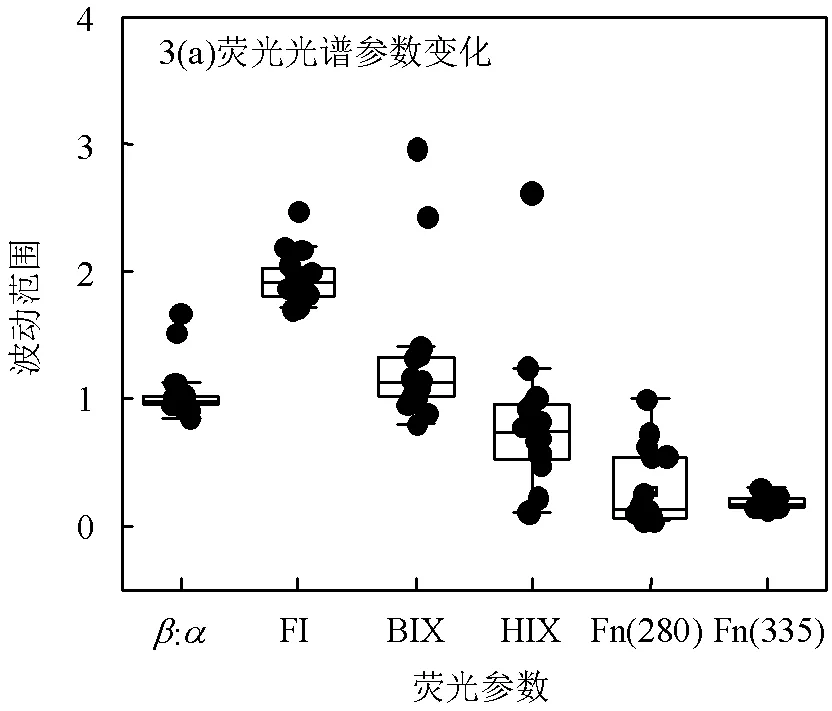

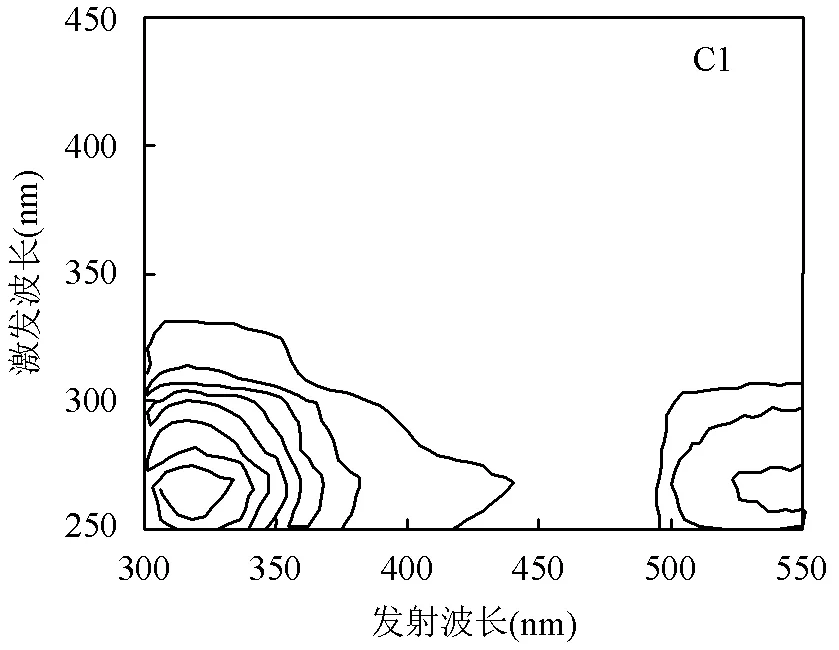


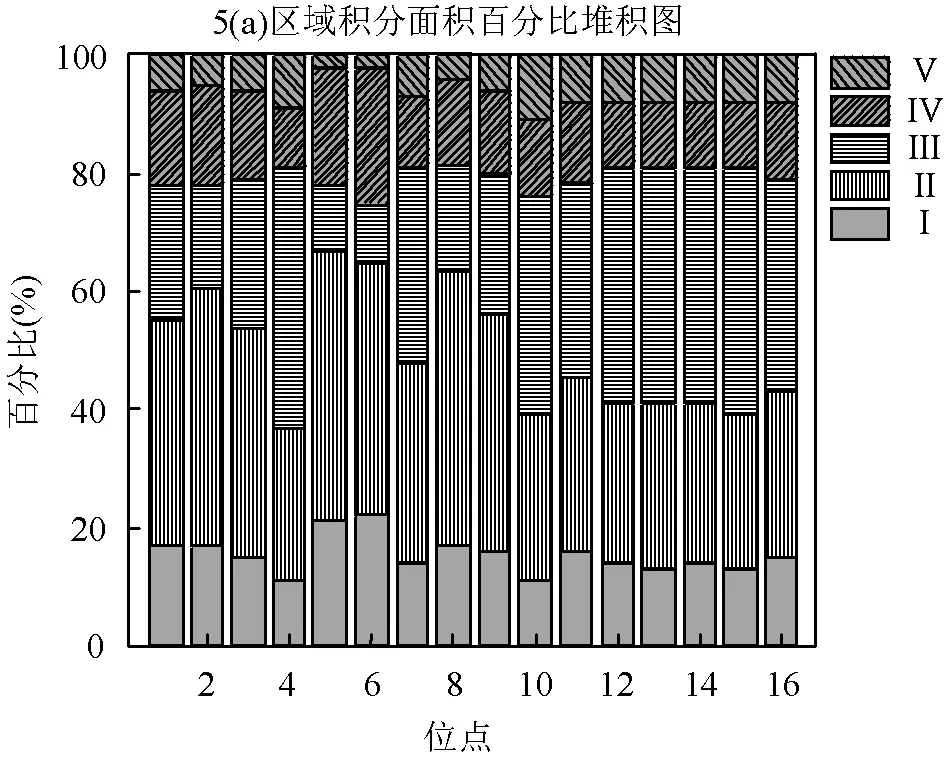
2.4 来源解析
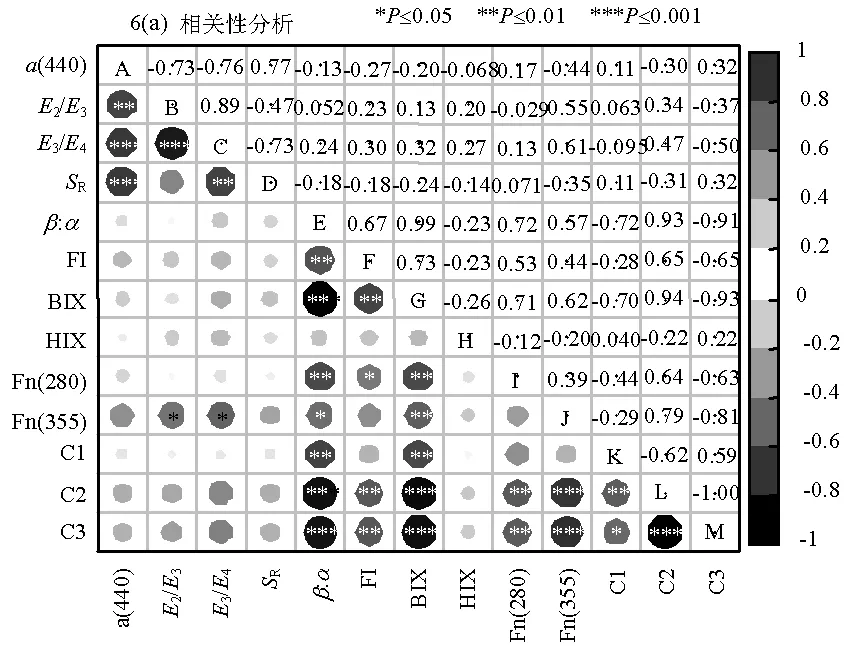
3 结论
